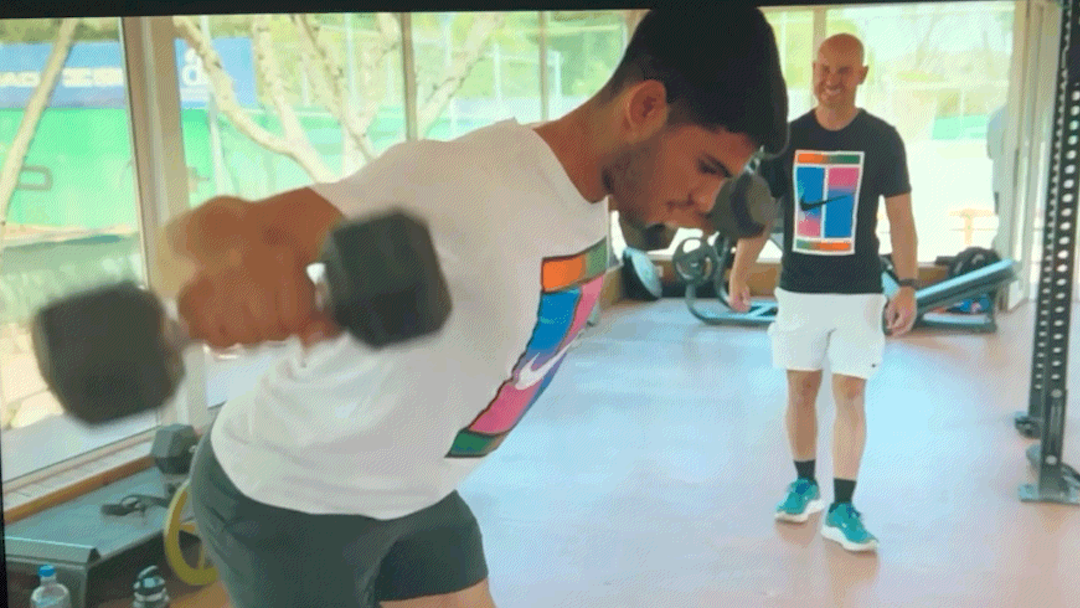Season 2, Episode 5 of the Netflix docuseries “Break Point” focused on how Jessica Pegula and Maria Sakkari struggled to win tournaments in 2023. Before the two players walked onto the court for a semi-final head-to-head match-up at that tournament, a montage of them in the ready room was shown. It is a treasure trove of ideas for tennis-specific functional training. For example, Pegula was briefly shown performing an exercise that starts with a familiar motion and then takes a fascinating twist.
The exercise starts as a lateral step-up, a standard strength and balance exercise. A basic lateral step-up is performed by standing beside an elevated surface, such as a bench or plyo box, placing one foot on the bench, and lifting the body weight until the other foot can be placed onto the surface. This movement is focused on single-leg strength of the quadriceps, glutes, hamstrings, and calves. It also engages the core to maintain stability and thus is also good for balance.
Pegula is seen performing a variation. She twists her body 180° while switching the foot on the bench and continuing the rotation for another 180° as she lowers her body to the opposite side of the bench from where she started. To complete one rep, she reverses the motion in the opposite direction. This is one of those cases where an animated gif is worth a thousand words, so people whose email clients or web browsers block images should navigate to it directly.

When I first saw Pegula perform this exercise on the show, I immediately thought, “Don’t try this at home, kids.” It is almost like the show’s film crew reminded Pegula that she was about to play Sakkari and thus should consider doing something to match the Greek player’s insane training energy and gym moves.
Pegula performs her twist variation of the lateral step-up under close supervision, and she has a clear space for this exercise to be safely performed. She is also a professional athlete who probably built up to it by first developing the basic lateral step-up before moving on to that advanced variation. That is probably where most recreational tennis players should start… and arguably stay.
A lateral step-up is performed by standing beside an elevated surface with one foot placed securely on it. Pressing through the heel of the elevated foot, the body is lifted by fully straightening the leg. It is brought up to the level of the surface and then lowered down to the starting position in a controlled manner. Maintaining an upright posture and engaged core throughout the exercise is important to maximize effectiveness and minimize the risk of injury.
For tennis players, lateral step-ups offer several benefits. The exercise simulates functional movements commonly seen on the tennis court and is excellent for improving agility and lateral stability. The focus on single-leg strength is particularly valuable, as tennis involves frequent starts, stops, and direction changes. Additionally, this exercise helps enhance joint stability and control, which is critical for preventing injury.
I have a high-quality, sturdy training bench in my home gym, but when I’m in my hometown lending a helping hand to my Mom, I only have a plyo box. Using that equipment rather than a bench has some advantages. Many plyo boxes have a more textured “grippy” surface than a standard weight bench, which reduces the risk of slips. Additionally, plyo boxes provide various heights, making it easy to adjust the difficulty level and customize the intensity of the workout.
While preparing to write about this exercise, I started obsessing over a new plyo box that creepily popped up on Amazon’s “Related Items” suggestions within the past week. This wooden version appears to be far sturdier than the foam core box I have in my home gym. I imagine that would provide better stability for this particular exercise—which would be critical if I ever try Pegula’s variation. A more secure landing platform would give me the confidence to push harder in my workouts without worrying about instability.

3 in 1 Non-Slip Wooden Plyometric Box (<- Sponsored Link)
Incorporating exercises like Pegula’s twist on the lateral step-up into a training routine can give tennis players a challenging, sport-specific workout that builds strength, balance, and agility. While diving into advanced variations is tempting, starting with the basics ensures a safer, more effective progression. For those inspired by elite athletes like Pegula, it’s not just about replicating the moves but about gradually building the foundation to handle them. The best results come from steady progress and a commitment to quality over intensity.
Fiend At Court participates in the Amazon associates program and receives a paid commission on any purchases made via the links in this article. Details on the disposition of proceeds are available on the “About Fiend at Court” page.



